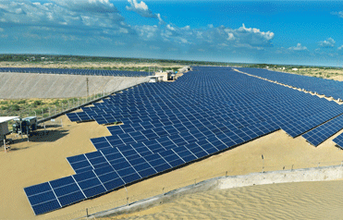
When the team began work at the site in the third week of May, it was not the best time to be in Rajasthan. The harsh summer months made it nearly impossible to work long hours during the day, but the team had no options. The nights offered scant respite as the sunburnt, sleep-deprived team worked under floodlights to complete the project in time.
Levelling up
The first challenge was the uneven terrain, spread over 26 acres, with sand dunes as high as 50 feet. Flattening it meant moving 3.5 lakh cubic metres of sand. Forty tractors worked simultaneously all day on-site, with a brief reprieve between 11am and 4pm, to lay the foundation for the module mounting structures. Multiple teams worked to average a run-rate of 150 foundations a day. It took them almost a month to complete 3,000 foundations.

Sustainability makes sound business sense. Moreover, it is about doing the right thing for the future, says Ravi Khanna, CEO, Solar Business, Aditya Birla Group
Raring to go
The team realised quite early that it could not depend solely on the engineering, procurement and construction (EPC) contractor. Team members monitored all aspects of the project and were present at the site to supervise quality. Come August, and the team was raring to install the modules, but there was no respite from the unusually heavy rains. The road from Jodhpur to Vituza was cut off by floods; the detour doubled the travel time from Jodhpur, just when the bulk of the supplies had to reach the site.
The next step was the mechanical assembly of the modules and the electrical connection. When the EPC contractor was not able to ramp up mechanical installation, the team arranged for sub-contractors to avoid any work delay. This move paid rich dividends as they began clocking 2,500-2,800 modules per day instead of the average daily run-rate of 150-200.
In the meantime, the switchyard work and the 11km, 33kV grid from the switchyard to the nearest 132 kV substation work was completed. As per plan, one transformer was synchronised with the grid on October 14. Starting from zero date on May 23, the project was grid-connected on October 14, thus meeting connectivity and capacity installation deadlines, and achieving savings against the budgeted capex.
Initial estimates revealed that the team had exceeded expected projected returns. The remaining transformers were synchronised over the next fortnight. The plant, running successfully ever since commissioning, has performed beyond expectations. Estimated to generate 21,235kWh daily, the plant has been delivering a higher performance of 23,500kWh/day consistently ever since stabilisation.


























